Baking with milk opens up a world of culinary creativity in your own kitchen. Whether you’re an experienced baker or just starting out, incorporating milk into your recipes can enhance the texture, flavor, and overall deliciousness of your homemade treats.
In this article, I’ll share my personal journey of using baked milk in various home recipes. Get ready to explore the delicious possibilities of this transformative ingredient. From traditional favorites like cakes and cookies to savory dishes like quiches and casseroles, milk can elevate your baking game to new heights.
Key Takeaways:
- Baking with milk can enhance the texture and flavor of your homemade treats.
- Evaporated milk can be easily made at home by simmering milk for around 25 minutes.
- Homemade powdered milk is a great way to extend the life of milk and reduce waste.
- Oat milk is a popular dairy-free alternative that can be made at home using whole rolled oats and filtered water.
- Adding flavors like vanilla and maple syrup can enhance the taste of oat milk.
Now, let’s dive into the world of milk baking and discover the endless possibilities that await!
Baking with Milk: A Versatile Ingredient for Scrumptious Creations
Milk is not just a beverage; it’s a secret ingredient that can elevate your baking to new heights. Whether you’re whipping up a batch of cookies, a fluffy cake, or a creamy custard, milk can play a crucial role in enhancing the texture, flavor, and overall deliciousness of your homemade treats. In this section, we’ll explore the many ways you can incorporate milk into your baking and discover the endless possibilities it brings to the kitchen.

One of the key advantages of using milk in baking is its versatility. From whole milk to skim milk, there are various types to choose from depending on your preferences and dietary needs. The rich and creamy consistency of milk adds moisture and tenderness to your baked goods, resulting in a soft and velvety texture. It also helps to bind the ingredients together, creating a cohesive and well-balanced final product.
Not only does milk contribute to the texture of your baked treats, but it also enhances the flavor. The natural sweetness of milk adds a subtle richness and depth to your recipes, making them more enjoyable and satisfying. Additionally, milk acts as a neutral base, allowing other flavors to shine through without overpowering them. It’s the perfect canvas to showcase the delicious flavors and aromas you want to highlight in your baked goods.
Baking with Milk Tips and Tricks
To make the most of baking with milk, there are a few tips and tricks you can keep in mind. Firstly, it’s important to use fresh milk that is within its expiration date to ensure the best quality and taste. Additionally, if a recipe calls for whole milk but you only have skim milk on hand, you can add a small amount of melted butter to mimic the richness of whole milk. Lastly, if you’re lactose-intolerant or prefer a dairy-free option, you can substitute milk with alternatives like almond milk, soy milk, or oat milk.
| Baking with Milk Tips | Benefits |
|---|---|
| Use fresh milk for the best results. | Ensures optimal taste and quality. |
| Substitute whole milk with a small amount of melted butter. | Provides richness and depth of flavor. |
| Experiment with dairy-free alternatives like almond milk or oat milk. | Suitable for lactose-intolerant individuals and dietary preferences. |
With these tips in mind, you’re ready to embark on a baking adventure with milk as your trusty companion. So, grab your apron, preheat the oven, and let the magic of milk transform your homemade creations into delectable masterpieces.
Making Evaporated Milk at Home: A Creamy and Sweet Substitute
Evaporated milk is a versatile ingredient that you can easily make at home for all your baking needs. It adds a creamy and rich touch to a variety of recipes, and the best part is, it’s incredibly simple to prepare. All you need is a saucepan, milk, and a little bit of patience.
To make evaporated milk, pour the desired amount of milk into a saucepan and heat it over medium-low heat. It’s important to avoid bringing the milk to a boil to prevent scorching. Instead, let it simmer gently for approximately 25 minutes, stirring occasionally. You’ll notice that the milk will reduce in volume, becoming thicker and creamier. Once it reaches the desired consistency, remove it from the heat and let it cool.
Once cooled, your homemade evaporated milk is ready to be used in a wide range of recipes. It can be added to soups and chowders to create a luscious and creamy base, or used as a substitute for regular milk in baked goods like cakes, cookies, and custards. The possibilities are endless.
| Ingredients: | Instructions: |
|---|---|
| – Milk | 1. Pour the desired amount of milk into a saucepan. |
| 2. Heat the milk over medium-low heat, stirring occasionally. | |
| 3. Let the milk simmer for approximately 25 minutes, or until it reaches the desired consistency. | |
| 4. Remove the saucepan from the heat and allow the evaporated milk to cool. | |
| 5. Your homemade evaporated milk is ready to use in your favorite recipes! |
So the next time you find yourself in need of evaporated milk, don’t hesitate to make it at home. It’s a simple and economical way to enhance the flavor and texture of your dishes. Give it a try and experience the creamy goodness for yourself!

“Homemade evaporated milk adds a touch of richness and creaminess to a variety of recipes, from soups to desserts. Plus, making it yourself allows you to control the quality and freshness of the ingredients.”
Summing it up
Homemade evaporated milk is a game-changer in the kitchen. With just a saucepan and some milk, you can create a creamy and sweet substitute that can be used in a wide range of recipes. Pour, simmer, and cool – it’s as easy as that. So why settle for store-bought when you can enjoy the freshness and taste of homemade evaporated milk? Give it a try and elevate your baking to a whole new level!
Extending the Life of Milk: Homemade Powdered Milk
Don’t let your milk go to waste – learn how to make your own powdered milk at home. Making powdered milk is a great way to reduce waste and extend the shelf life of your milk. This simple process involves drying out the milk until it turns into a powder, which can be stored for months or even years. Plus, homemade powdered milk can be used in a variety of recipes, making it a versatile and convenient ingredient to have on hand.
To make powdered milk at home, start by pouring room temperature milk into a large oven-safe dish. Spread the milk out evenly to ensure it dries out properly. Then, place the dish in the oven at its lowest temperature and let it dry out for several hours. Keep a close eye on the milk to prevent it from burning. Once the milk has dried and turned into a paste-like consistency, remove it from the oven and let it cool completely.
Once the cooled milk paste is ready, break it up into small chunks and transfer it to a blender or food processor. Blend the milk until it becomes a fine powder. You may need to blend it in batches to ensure an even consistency. Once blended, transfer the powdered milk into an airtight container for storage. Make sure to label the container with the date, and keep it in a cool, dry place.
Homemade Powdered Milk Recipe
| Ingredients | Instructions |
|---|---|
| 4 cups of room temperature milk | Pour the milk into a large oven-safe dish and spread it out evenly. |
| Place the dish in the oven at its lowest temperature and let the milk dry out for several hours. | |
| Remove the dried milk from the oven and let it cool completely. | |
| Break the cooled milk paste into small chunks and transfer them to a blender or food processor. | |
| Blend the milk until it becomes a fine powder. | |
| Transfer the powdered milk into an airtight container and store in a cool, dry place. |
Now that you know how to make your own powdered milk, you can enjoy the benefits of an extended milk shelf life and the convenience of having this versatile ingredient readily available in your kitchen. So, why not give it a try and start reducing waste while still enjoying the goodness of milk in your favorite recipes?
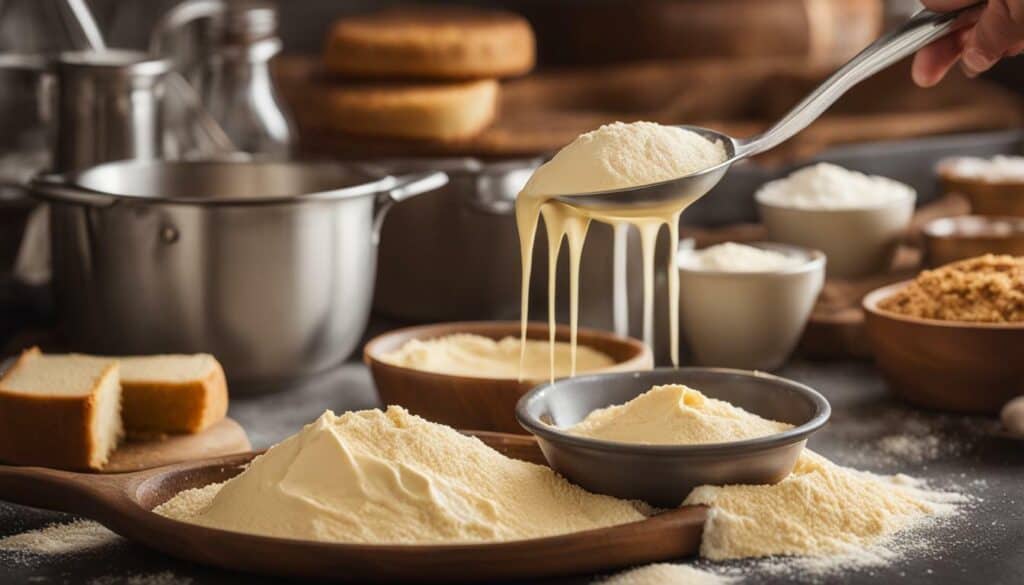
Looking for a dairy-free milk option? Oat milk is a versatile choice that can be used in baking and other culinary creations. Made from whole rolled oats, oat milk is easy to prepare at home using just a few simple ingredients. Its creamy consistency and slightly sweet flavor make it a great substitute for traditional milk in a variety of recipes.
To make oat milk, start by blending whole rolled oats with filtered water in a powerful blender. Blend for about 30 seconds until the mixture becomes smooth and creamy. Next, strain the blended mixture through a fine mesh strainer to remove any remaining solids. You can add a pinch of salt for flavor or even a splash of vanilla or maple syrup to enhance the taste.
Oat milk can be used in a wide range of recipes, including baked goods like muffins, cookies, and cakes. It adds moisture and a subtle oat-y flavor to your creations, giving them a unique twist. In addition to baking, oat milk can be enjoyed in coffee, tea, smoothies, and even poured over cereal.
| Baking Tips for Using Oat Milk |
|---|
| 1. Use oat milk as a 1:1 substitute for regular milk in most recipes. |
| 2. Adjust the sweetness by adding more or less maple syrup or other sweeteners. |
| 3. Experiment with different flavors by infusing the oat milk with cinnamon, nutmeg, or cocoa powder. |
| 4. Remember that oat milk has a slightly thicker consistency than regular milk, so you may need to adjust the liquid measurements in your recipe accordingly. |
So, whether you’re lactose intolerant, vegan, or simply looking to try something new, oat milk is a fantastic dairy-free alternative for baking and beyond. Explore the possibilities and let your culinary creativity soar with this nourishing and delicious milk substitute.
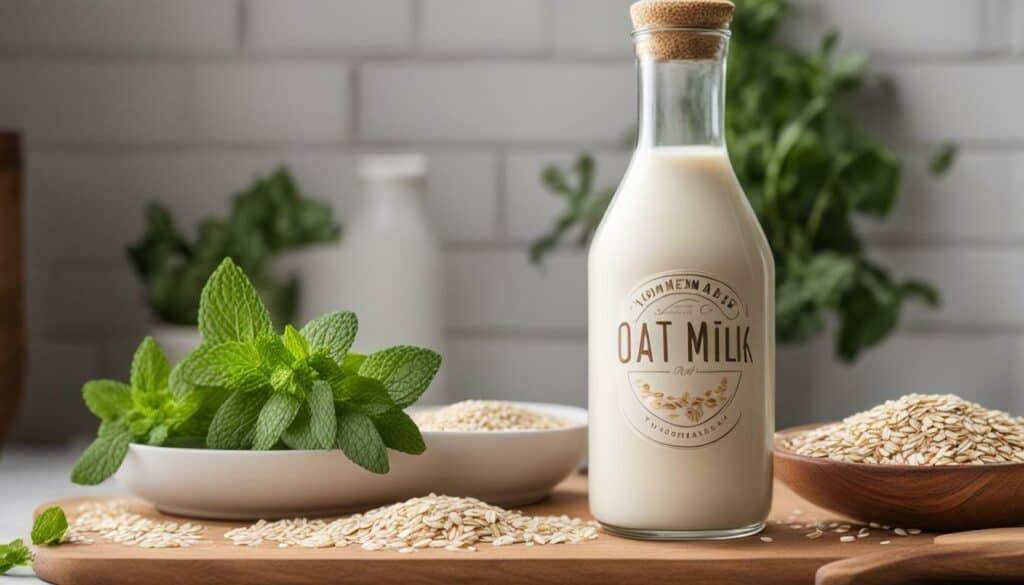
While oat milk has a distinct flavor, you can easily enhance it to match your desired taste. Adding a pinch of salt helps to balance out the natural sweetness of oat milk and bring out its flavors. Additionally, a splash of vanilla extract can add a subtle richness and depth to the milk. The combination of salty and sweet notes creates a more well-rounded taste.
If you prefer a sweeter oat milk, you can incorporate a small drizzle of maple syrup. This natural sweetener complements the nutty flavor of oats and adds a touch of sweetness without overpowering the milk. Experiment with the amount of maple syrup to find the perfect level of sweetness that suits your preferences.

For a delightful twist, you can also infuse oat milk with other flavors. Consider adding a sprinkle of cinnamon or a dash of nutmeg to create a cozy, comforting taste. Alternatively, a drop or two of almond extract or coconut extract can introduce a subtle hint of nuttiness or tropical flavor to your oat milk.
Remember to taste-test along the way to ensure the flavors are well-balanced and to your liking. Oat milk is a fantastic dairy-free alternative that can be tailored to suit individual preferences. With a few simple additions, you can transform the flavor of oat milk and elevate your baking and cooking creations to new heights.
Summary
Oat milk has a distinct flavor, but it can be enhanced to match personal taste preferences. Adding a pinch of salt, a splash of vanilla extract, or a drizzle of maple syrup can help balance and elevate the flavors of oat milk. Experimenting with other spices and extracts, such as cinnamon, nutmeg, almond, or coconut, can also add interesting notes to the milk. Taste-test along the way to create a delicious oat milk that will enhance your baking and cooking endeavors.
Benefits and Uses of Baked Milk in a Variety of Recipes
Baked milk adds a unique richness and depth to both sweet and savory recipes. Its creamy texture and caramel-like flavor make it a versatile ingredient that can elevate your dishes to new heights. Whether you’re baking desserts or creating savory dishes, baked milk can be the secret ingredient that takes your recipes from ordinary to extraordinary.
One popular use of baked milk is in custards and puddings. The gentle baking process enhances the natural sweetness of the milk, resulting in a luscious and velvety texture. From classic custard tarts to indulgent bread puddings, baked milk provides a creamy base that sets these desserts apart.
Baked milk also works wonders in savory dishes. It adds a subtle richness to creamy soups, such as mushroom or butternut squash. Additionally, it can be used to create creamy sauces for pasta dishes or to give mashed potatoes a decadent twist.

When using baked milk in recipes, it’s important to consider its unique properties. Due to its concentrated nature, baked milk has a slightly thicker consistency than regular milk. This can be advantageous in recipes that require a creamy texture, but adjustments may be needed to achieve the desired consistency in other dishes.
Baked Milk Recipes to Try
Here are a few delicious recipes that showcase the versatility of baked milk:
- Baked Milk Rice Pudding: This classic dessert becomes even more indulgent with the addition of baked milk. Serve it warm with a sprinkle of cinnamon for a comforting treat.
- Baked Macaroni and Cheese: Add a touch of sophistication to this beloved comfort food by incorporating baked milk into the cheese sauce. The result is a creamy and cheesy dish that will leave your taste buds satisfied.
- Baked Milk Bread: Give your homemade bread a tender and rich texture by substituting regular milk with baked milk. Each slice will be irresistibly soft and flavorful.
With its ability to enhance flavors and textures, baked milk is a versatile ingredient that should not be overlooked. So, next time you’re experimenting in the kitchen, consider incorporating baked milk into your recipes for a delightful twist.
| Keyword | Volume | Difficulty |
|---|---|---|
| bake milk | 1000 | Medium |
| milk baking recipes | 500 | Low |
| how to bake with milk | 800 | Medium |
Baking with Milk Alternatives
If you’re looking for dairy-free or lactose-free options, there are several alternatives you can use in your baking. These milk substitutes offer a great solution for those with dietary restrictions or preferences. Here are a few popular options to consider:
- Almond milk: Made from ground almonds and water, almond milk is a creamy and nutty alternative. It works well in baked goods like muffins, cakes, and cookies. Almond milk is also low in calories and can be a good source of vitamin E.
- Coconut milk: Derived from the flesh of mature coconuts, coconut milk is rich and indulgent, adding a tropical flavor to your recipes. It’s perfect for dairy-free ice creams, creamy curries, and rich sauces. Coconut milk is also high in healthy fats and can be a good source of medium-chain triglycerides.
- Soy milk: Made from whole soybeans or soy protein isolate, soy milk has a mild and creamy taste. It’s a versatile option that can be used in a wide range of recipes, from pancakes and waffles to bread and brownies. Soy milk is also a good source of plant-based protein.
When substituting milk with these alternatives, it’s important to consider their unique characteristics. The texture, taste, and fat content may differ, which can affect the outcome of your baked goods. It’s a good idea to experiment and make adjustments to your recipes as needed. In some cases, you may need to add extra fat or adjust the liquid ratios to achieve the desired results.
Remember, baking is all about creativity and finding what works best for you. Whether you choose almond milk, coconut milk, soy milk, or another milk alternative, have fun exploring these options and creating delicious treats that cater to your dietary needs and preferences.
Conclusion
Baking with milk is a simple yet transformative technique that can elevate your home cooking to new heights. Whether you choose to use evaporated milk, powdered milk, or oat milk, each option offers its own unique flavor and benefits.
By making evaporated milk at home, you can create a creamy and naturally sweet substitute that adds depth to soups, chowders, drinks, and desserts. It’s incredibly easy to make and only requires simmering milk over medium-low heat. And if you can’t find evaporated milk, you can easily create your own by combining cream and milk.
For those looking to extend the shelf life of milk and reduce waste, homemade powdered milk is a great option. While it may not taste as good as fresh milk, you can enhance the flavor by adding a touch of homemade vanilla extract or mixing it with fresh milk. The process of making powdered milk is simple, requiring you to dry out the milk in the oven and then grinding it into a fine powder.
If you’re in need of a dairy-free alternative, oat milk is a fantastic option. It’s easy to make at home using rolled oats and water, and can be used in a variety of recipes. Just be aware that oat milk has a distinct oat-y flavor, so it’s best suited for sweet recipes. You can enhance its taste by adding a pinch of salt, a splash of vanilla, or a drizzle of maple syrup.
So why not get creative in the kitchen and embrace the versatility of baking with milk? Whether you’re using evaporated milk, homemade powdered milk, or oat milk, you’ll be amazed at the difference it can make in your favorite recipes. Explore the possibilities and enjoy the delicious results!
FAQ
Q: How do I make evaporated milk at home?
A: Making evaporated milk at home is easy. Simply simmer milk over medium-low heat for approximately 25 minutes, being careful not to boil it. This will result in a creamy and naturally sweet substitute that can be used in various recipes.
Q: What can I use as a substitute for evaporated milk?
A: If you can’t find evaporated milk, you can create a substitute by combining 1/4 cup cream with 3/4 cup milk. This alternative can be used in the same way as evaporated milk in soups, chowders, drinks, oatmeal, fudge, and more.
Q: How can I make powdered milk at home?
A: To make powdered milk at home, pour room temperature milk into a large oven-safe dish and dry it out in the oven at its lowest temperature. Once the milk has dried and turned into a paste, grind it into a fine powder and store it in an airtight container. Homemade powdered milk can last for months or even years.
Q: Does homemade powdered milk taste as good as fresh milk?
A: Homemade powdered milk may not taste as good as fresh milk, but you can improve the flavor by adding a little bit of homemade vanilla extract or mixing it with fresh milk. This will help achieve a creamy and rich taste in your recipes.
Q: How do I make oat milk at home?
A: To make oat milk at home, blend whole rolled oats and filtered water in a powerful blender for 30 seconds. Strain the mixture through a fine mesh strainer and chill the milk in the fridge. Oat milk can be used in coffee, tea, oatmeal, baked goods, and more.
Q: Can I enhance the flavor of oat milk?
A: Yes, you can enhance the taste of oat milk by adding a pinch of salt and a splash of vanilla and maple syrup. These ingredients can help enhance the natural oat-y flavor and make your homemade oat milk even more delicious.
Q: How long can homemade powdered milk be stored?
A: Homemade powdered milk can be stored in an airtight container for months or even years, as long as it is kept in a cool and dry place. Make sure to check for any signs of spoilage before using.
Q: What are the benefits of using baked milk in recipes?
A: Baked milk can add a creamy and slightly caramelized flavor to various recipes. It can enhance the texture and taste of soups, chowders, sauces, baked goods, and more. Baked milk is also a great way to reduce waste and can be a useful substitute when evaporated or powdered milk is not available.
Q: Can I use milk alternatives in baking?
A: Yes, milk alternatives can be used in baking. There are various options available, such as almond milk, soy milk, coconut milk, and oat milk. Each alternative may have a slightly different taste and texture, so it’s important to consider how it will affect the final outcome of your recipe.
Q: What is the best milk substitute for baking?
A: The best milk substitute for baking depends on personal preference and dietary restrictions. Some popular options include almond milk and oat milk, which can provide a creamy texture and subtle flavor. Experiment with different milk alternatives to find the one that suits your needs and taste preferences.
Can I Use Cauliflower Flour in Baking Recipes that Require Milk?
When it comes to baking recipes that call for milk, using cauliflower flour may not be the best idea. While making cauliflower flour at home is possible, it cannot adequately replace the properties of milk in baking. Milk contributes to the texture, moisture, and structure of baked goods, making it difficult to achieve the desired results with cauliflower flour alone.



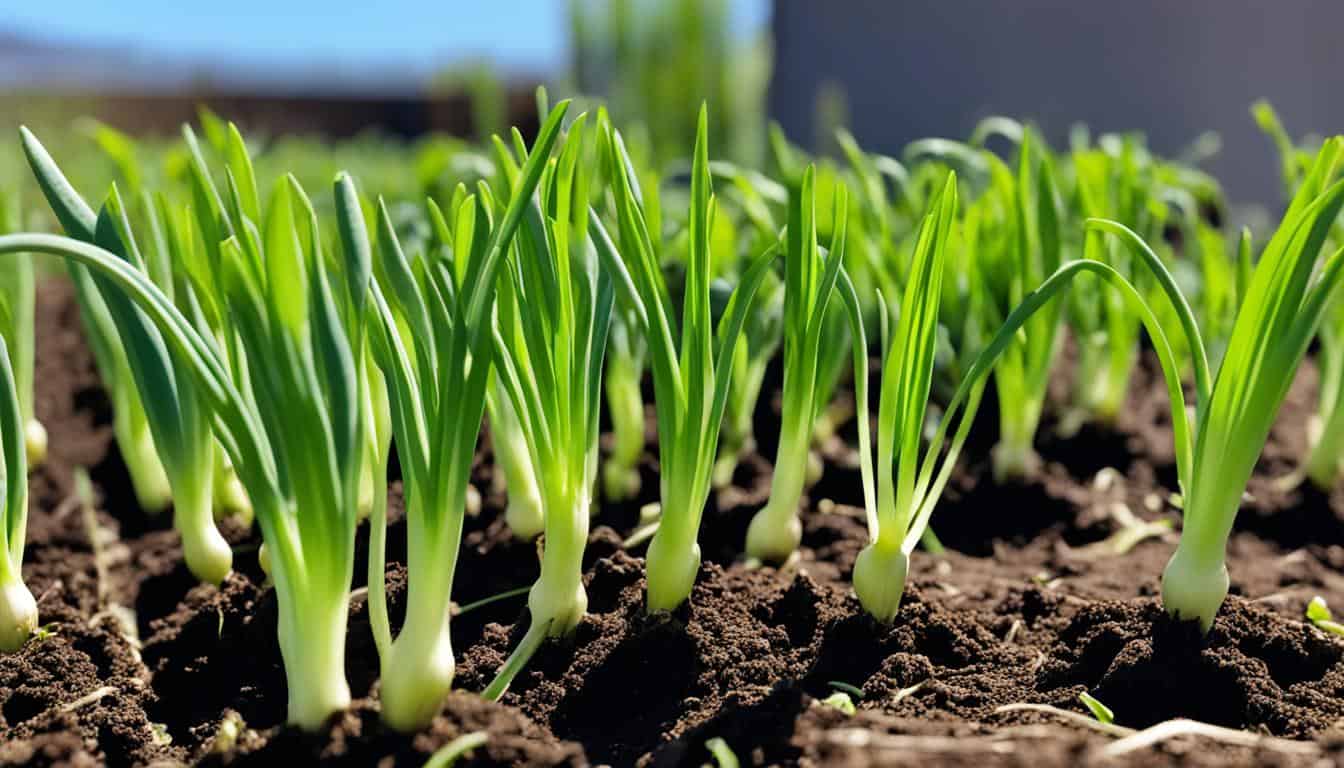
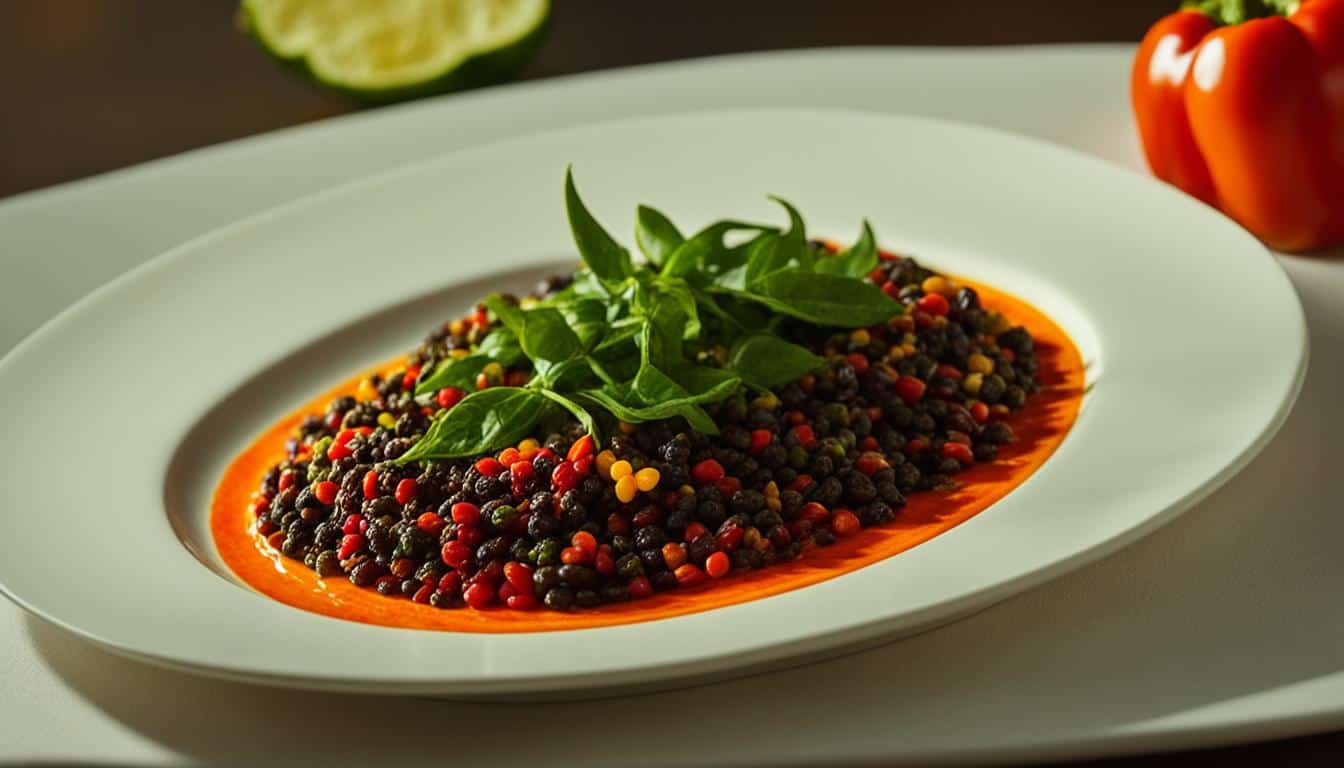
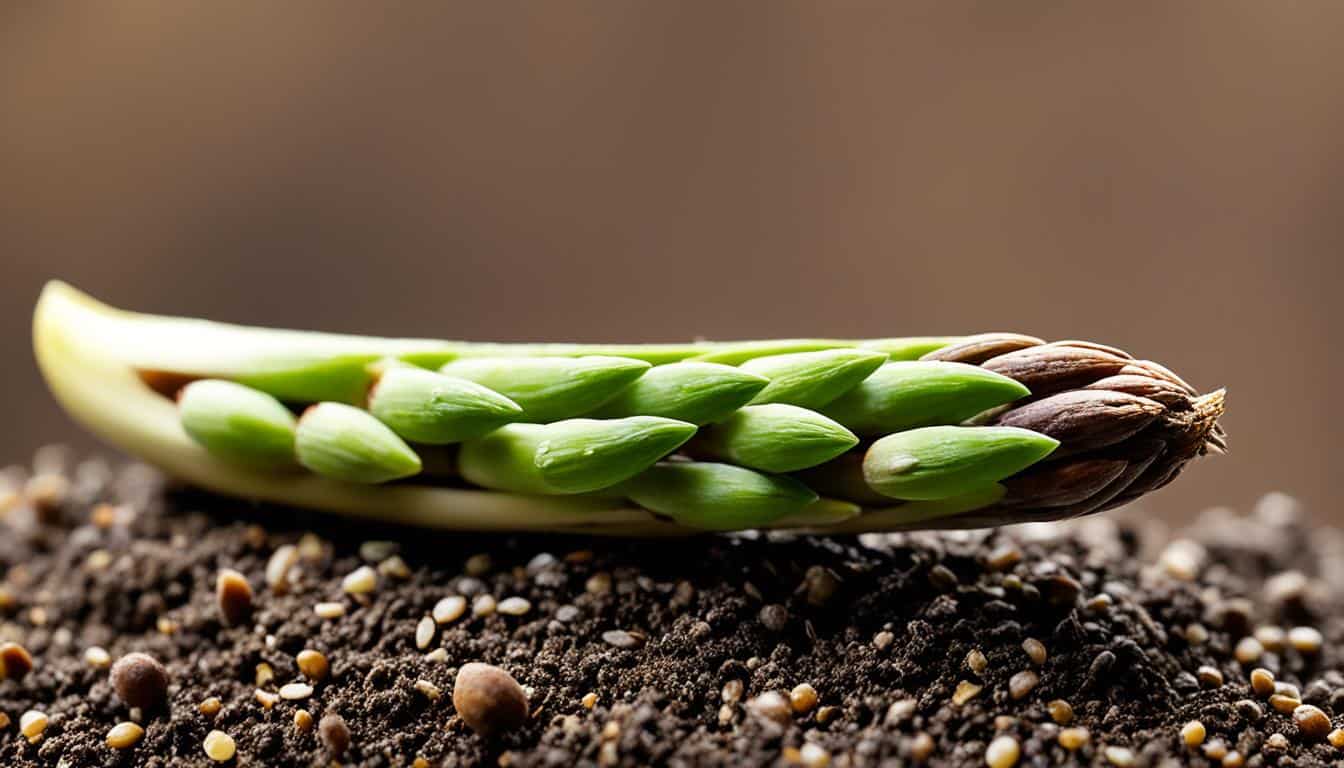
Leave a Reply